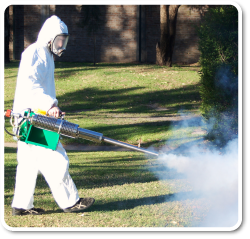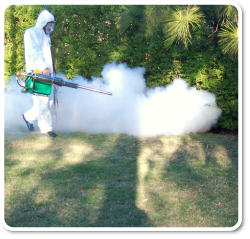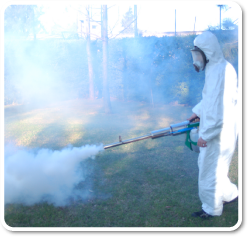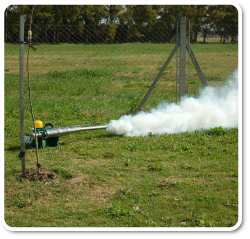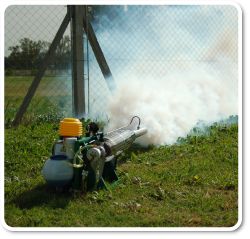The thermal fogging
The thermal fogging is a technique widely used in pest control, vector and disinfection routines in the area of public health.
This technique differs from other spraying methods, mainly by the size of the droplets produced, which are in the order of 10 microns in diameter. This small droplet size is achieved through a double process, which simultaneously sprays and partially evaporates the formulation through the use of thermo-pneumatic energy.
How does a thermal fogger operate?
In a thermal fogger, the formulation (mixture of the active ingredient with a carrier that is usually a mineral oil), is exposed to a hot air current coming from the exhaust of a pulse-jet engine.
The high velocity and temperature of these gases causes immediate fragmentation and partial evaporation of the fluid which is expelled through the exhaust pipe. As soon as it encounters with the ambient air at a much lower temperature, this stream is condensed into tiny droplets that form a dense fog.
This mist contain an appropriate dose of the active ingredient in each of the micro droplets that compose it, and has the ability to "float" and move long distances without losing their effectiveness, penetrating and accessing sites with dense vegetation, reaching the most inaccessible places within a warehouse or store.
Types of formulation
This technique allows the use of 2 basic types of formulations. It is called formulation to the mix of the active ingredient with the carrier used for dilution. Depending on the type of carrier used, we may have:
• Water-based formulations
• Oil-based formulations
Water-based formulations
It is used in cases where you do not want to leave a thin oily film on objects within the area to be sprayed. However, water-based formulations have the following disadvantages:
• The micro droplets generated are larger and heavier due to the poor thermal properties of water sprays.
• The droplets are also more vulnerable to evaporate before they can reach or impact on its target due to its poor ability to travel long distances, because of their greater weight originated in its larger size. This limits their use in a large interior space, where the fog is intended to cover all the spaces and surfaces of it.
• The thermal fogger can not work properly with the same flow rate with aqueous formulations than oily formulations. The lower viscosity of water compared to mineral oil, requires a reduction of the flow rate of formulation to avoid generating droplets of larger size that are not effective in such treatments. For this reason, the use of water-based formulations is generally accompanied by a reduction of the diameter of the formulation nozzle.
Oil-based formulations
They are the most widely used because the tiny droplet size produces better performance and achieves a high effectiveness of the active ingredient besides ensuring excellent coverage in large spaces.
However, such formulations are generally flammable and since thermal foggers have elements operating at high temperatures is essential to strictly observe all safety rules contained in the operating manuals for this equipment.
